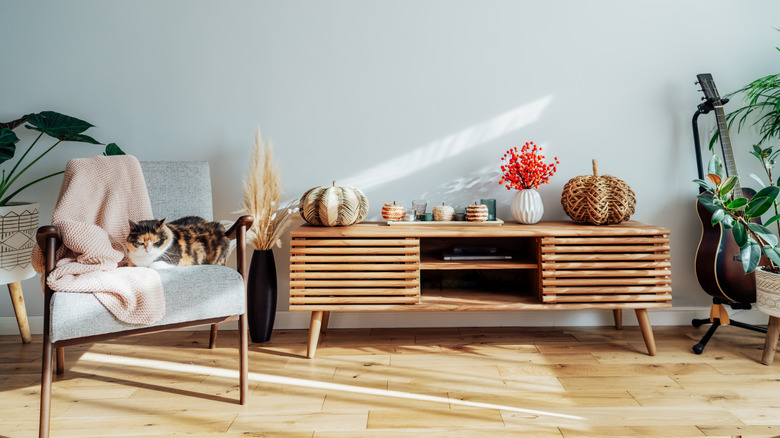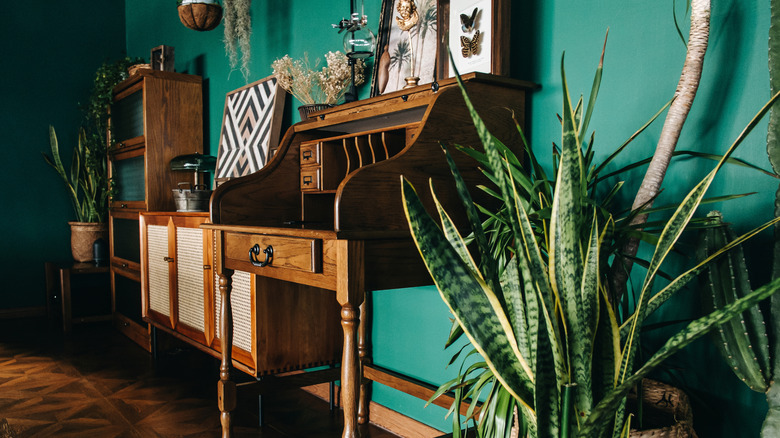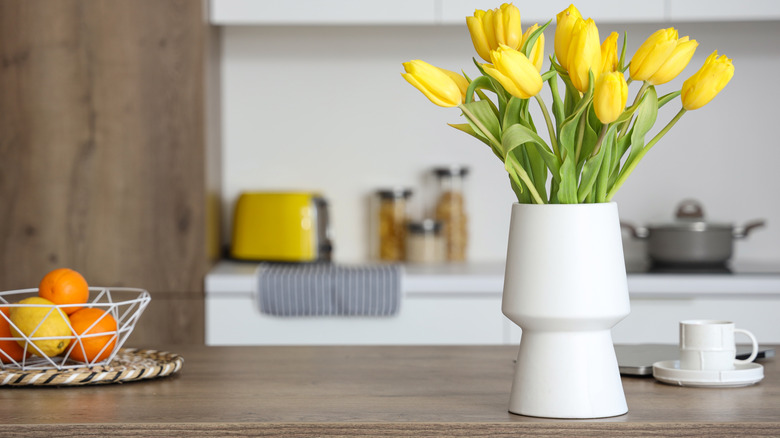Why Your Wood Decor Looks Off (And The Rule That Fixes It)
We may receive a commission on purchases made from links.
If your wood decor feels more like a random mashup than a carefully tailored showcase...you're not alone. Sometimes, it's a struggle to blend wood with your other furnishings effectively, but there is a simple rule that fixes this issue: identify the undertones of your wood decor and then pair them with complementary colors–for example, using shades of blue or green alongside warmer-toned woods, and incorporating warm shades of burgundy or pink, and even yellows, to make a statement against woods with neutral or cool undertones.
So, how do you identify wood undertones? The undertones are those barely noticeable color tints that ultimately shape the woods' dominant tone. For example, deep, heavy tones like walnut, mahogany, and ebony are usually classified as warmer (and sometimes "red") wood undertones. These woods tend to have subtle shades of orange, red, or even yellow as a supporting tone within their texture.
On the other hand, woods with more neutral or "cool" undertones include pine, white oak, and ash. These woods tend to carry slight traces of blue or gray in their base — colors that are usually referred to as "cool" on the color spectrum. If your wood decor looks more chaotic than crafted, apply the "undertone rule" by considering the primary tones of your walls, floors, furniture, and other design elements to promote stylistic harmony.
Match warm undertones with cool blues and greens
The great thing about working with warm undertones is that they often go great with bold looks that energize a space or relaxed, homey setups for a more cozy feel. So, try pairing that mahogany bed and dresser set with blue bed sheets, such as cyan or azure. Consider adding a royal blue or teal-painted accent wall for a little more pigment in the space. And don't forget about those window coverings, as drapes and blinds can help set the mood. These are also conveniently located places to sprinkle in a few green-tone palettes (think pale green or mint) to create a comfortable, soft atmosphere.
The right color combos in your kitchen can make it go from uninteresting and dull to lively and breezy. Need to spice up that cherry dining room table? Try matching it with a turquoise or fern green tablecloth, like this Picpeak Japanese-Style Table Runner, with matching chair pillows. Or, you can top it with a vase of the same color and a few light flowers, like these Hananona artificial lilies. Look to your countertop accessories for more ideas. Liven up your kitchen area with apple-green-colored ceramic storage containers, cabinets, or pot holders. And, of course, you can't forget about the cabinetry — this is a great place to add a lot of color to make your warm wood tones pop. Experiment with different kitchen color combinations to see what works best.
Pair cool wood undertones with pops of bright color
Designers and decorators often pair cool wood tones with complementary colors that may include berry, brick red, flamingo, or other burgundy or pink shades. Also, warm yellows, such as blonde or jasmine, are commonly paired with these woods. You'll discover that there are a lot of "in-between" shades when you're looking for a paint color or styling pieces for a room. Pair white oak flooring with a buttercup or yellow-orange couch set with matching pillows for a timeless yet refreshing aesthetic. Add more notes of yellow with the items, such as the LCCCK Donut Vase, reading books, or a pink vase with dark flowers. For extra flair, make the yellow hues in a room pop by tossing a pale pink throw on a nearby couch.
Or, let's say you want to make a statement with your dining room. You have an ash dining room table and want a sophisticated or elegant theme for the space. You can easily make the magic happen by bringing a few pieces containing amaranth or wine red shades. Consider adding a table runner or a rug, similar to this Socomi Burgundy Table Runner or this Engiw distressed vintage area rug.
One interesting way to create a noticeable decor scheme with cooler wood undertones is to use your centerpieces to complement these tones. Statement pieces, such as a large wall mirror with a saffron yellow frame or a mustard-colored cabinet, area rug, or accent wall, can make for striking visual elements. Remember, the bigger the decorative element, the bolder the statement.


